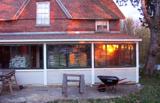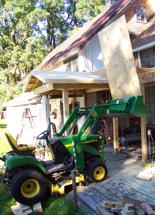
Category Archives: Tech Toys
Wordless Wednesday
I Lurve My Tractor
Subtitled: And I’m pretty fond of my come-along.
I spent Friday cleaning out the cellar. It was sunny and pleasant outside and I need the space for a root cellar.
This house was built about 1855. We know it wasn’t here for the 1850 tax roles (the earlier farmhouse was listed) and we know it was in 1860. We also know it had a cellar because
 Cellars in houses of a certain age are … interesting. This one starts with a dirt floor and a cistern.
Cellars in houses of a certain age are … interesting. This one starts with a dirt floor and a cistern.
I’m not sure exactly how many generations of the Stevens family worked this farm. Ira Allen first rented, then sold 180 acres to W.C. Stevens around the turn of the 19th century. He built the original house here on the rise where this house sits now. The original road from St. Albans to Canada came right past the front door and up across our driveway before heading north. The family tore down that first house but salvaged most of the lumber and the rubble stone foundation to build the house we live in today. They extended the foundation, doubling its footprint to build the new house with two wings, one brick, one frame. Its style is country Victorian.
One bequest in the family left “one bedroom plus full use of the cellar for storage” to the widowed Mrs. Stevens. She made good use of it.
We bought the house from the widow of a local judge who had in turn bought it from Mildred Stevens.
They made good use of the cellar, too.
It was sunny and pleasant outside so I spent the day cleaning out the cellar. Sheesh. Anne and I managed to haul out the 1950s frig that came with the house (we had put it down there and used it as our “second frig” until it stopped making cold), the freezer that froze up this winter, and a pair of water tanks one of which still had about 10 gallons of water innit.
 I lurve my tractor. It’s a “compact,” meaning it fits in between the typical lawn and garden style and the heavy duty workhorses of the modern farm. With about 24 diesel horsepower, it could pull a two-bottom plow better than my Ford 9N and yet it’s small enough to fit most places. And it has a 54″ wide bucket.
I lurve my tractor. It’s a “compact,” meaning it fits in between the typical lawn and garden style and the heavy duty workhorses of the modern farm. With about 24 diesel horsepower, it could pull a two-bottom plow better than my Ford 9N and yet it’s small enough to fit most places. And it has a 54″ wide bucket.
Remember that size.
My original plan, conceived not while in the shower, was simply to reach in the cellarway with the bucket, strap the stuff to the bucket, and deadlift it straight out. Unfortunately, the doorway is 6″ narrower than the bucket.
Time for Plan B.
I used the 2×12 I otherwise use for a scaffolding plank as a ramp. My tiedown straps are missing again so I dug out the anchor rode from the boat and put a couple of loops around the frig and dragged it up the ramp with the tractor. Did the same with the tanks. The freezer, actually lighter than the frig, was harder because it wanted to stand up on its side instead of sliding on its lid. I pulled it with the comealong because that was easier than dragging down the 100 pounds of railroad chain so I’d have enough reach.
I lurve my tractor. The top photo is part of the porch I finished four years ago; the lower one is the tractor lifting plywood onto the rafters to finish the now-finished porch. You can see the cellarway bay framed by the bucket arms, to the right of the portico. Having that bucket didn’t just make these jobs easier. It made the jobs possible.
The final indignity of the cellar project was to haul all that stuff up to the truck for its last open air ride to Hodgson’s. I used the tractor bucket.
The whole job was still a lot of stairs and a lot of work but I now have a lot more open floor down there. Maybe I’ll build some more shelves…
Voicemail
A very nice surgical physician’s assistant grabbed the couple of cysts I had mentioned. Easy peasy. He mostly shaved my chest and numbed me up with a quick acting, long lasting ‘caine-based anesthetic. Made a couple of cuts. Popped the cyst sacs out intact. Dug around in the bigger one to pull out all the scar tissue and cauterized the grave. Pulled the tissue together so there wouldn’t be too much depression. And did two layers of stitches. There are about 15 stitches all together.
The whole procedure was absolutely painless. And the dermatology practice will bill for just one procedure including the initial consultation, the excision, and even the return visit to remove the 27 miles of stitches. As an aside, people who can tie stitches awe me. I’m good with fine handwork. I can tie up a dinghy or a destroyer. I have no trouble with a reef knot. I have never mastered the surgeon’s knot in 4-0 silk.
They will also send the cysts themselves in for lab analysis. That will cost extra.
The phone call with the results won’t cost extra but it may not be painless.
 When Nurse Nancy said she would call me, I reiterated that she could leave a detailed message on my voicemail. See, I know that Health Insurance Portability and Accountability Act requires privacy so you have to fill out a form in quintuplicate and seal it with the blood of a goat to allow a doc to leave you a message.
When Nurse Nancy said she would call me, I reiterated that she could leave a detailed message on my voicemail. See, I know that Health Insurance Portability and Accountability Act requires privacy so you have to fill out a form in quintuplicate and seal it with the blood of a goat to allow a doc to leave you a message.
I had already given them the blood of the goat.
“Well, maybe I can,” she said.
Errr?
“Does your message identify you?”
Of course it does but apparently some people don’t.
“Lots of people leave the wrong number. Sometimes I don’t dial correctly. If I can’t tell for sure it is your voicemail, I can’t leave the message,” she said.
Geico called my cellphone and left a message for [name deleted] that their insurance wasn’t bound yet because they had not supplied enough information.
I don’t know if the poor schlub gave them the wrong number or if the Geico rep misdialed but not even my “Hi this is Dick Harper. Don’t leave a message and particularly don’t leave one for [name deleted]” outgoing message deterred them.
People.Just.Don’t.Listen.
Then there is the famed, federal Telemarketers’ Sourcebook (the FCC calls it the “Do Not Call” registry but we know they’re “here to help”). The first phone call in history happened on a nippy March day in 1876 when Alexander Graham Bell rang up Mr. Watson. “Come here. I want to see you,” he said. The second phone call in history happened later that chilly when a telemarketer called for “Mr. Fell” and offered to sell a genuine medicinal oil. The third phone call in history happened when Mr. Bell asked the Feds for help.
128 years later, a law made it illegal for telemarketers to call people on their list. Uh huh.
I get a lot of calls from “Consumer Svcs,” and “extended warranty” robocallers, and “Skycare,” and more. One enterprising phisherman even “spoofed” Swanton Lumber’s number. I do a fair amount of business with Swanton Lumber, so I answered that one. Snake oil.
The law doesn’t deter them. They just keep calling.
My outgoing voicemail message doesn’t deter them. They just keep calling.
My stadium air horn hasn’t deterred them. They just hire another, not-yet deaf, crook and just keep calling.
There are a number of hinky solutions such as anonymous call rejection, priority rings, and complete call blocking from your phone company to smart phone apps that do the same. My cordless phone has call block built in. All I do is scroll back through the Caller ID screen, select the offender, and save that number to the blocked list. Most amazing of all is that the phone turns off the call to my entire system so all the phones in the house stop ringing. I have no idea how that works. Black magic, I’m thinking.
People.Just.Don’t.Listen. but thanks to my phone’s extraordinary “Call Block” feature, I don’t have to listen either.
Tool Guy
Over the years I’ve built cars and houses and boats and batteries and computers and …
OK, you get the idea.
Over the years I’ve collected a lot of tools. A couple of them would go home at the end of the day but most went back in the toolbox or chest where they belong.
Over this summer I’ve had a little plumbing project.
 Stop it, Harper! This isn’t the Story of O. This is the story of Dick the Tool Guy.
Stop it, Harper! This isn’t the Story of O. This is the story of Dick the Tool Guy.
My great grandfather Barnard the farmer-engineer built cooling tunnels and had a small-gauge steam train on tracks in the front yard. He had tools. My grandfather Harper the station master built a wood shop in the baggage room of his station where he made lovely cabinets. He had more tools. My dad rebuilt most of our boat from that wood shop but he later moved it to our chicken coop where he made exquisite tables and more. This Vermont house has a nice 19th Century barn that I converted to my shop when we moved here.
I inherited and kept some of the tools my dad inherited. I inherited and kept all of his tools. And I’ve managed to buy one or two of my own.
Oddly, my dad and I shared most of the same tool preferences although he was a southpaw and always a Ford guy and I’m not. Still, you can’t tell the difference between his hand tools and mine. And I didn’t like my grandfather Harper’s hand tools but I did keep his Shopsmith.
I started the real assemblage when I started building race cars. In fact, the bed of my 22-foot long, green 1973 Chevy crew cab was more workshop than anything for the years we used it to haul race cars. The centerpiece of that was a stacked mechanic’s roller cabinet. The truck is long gone but I still have the tool box and now I’ve mostly duplicated them with my dad’s. (I got out of racing when it became apparent I’d need an 18-wheeler instead of a pickup).
Power tools are a whole ‘nother kettle of fish.
My dad was also a table saw guy. I lurve my radial arm. Now I have three table saws, the Shopsmith, and, natch, a good 12″ radial arm saw. Each one has its strong points although I find myself using one of the table saws more than the radial because I can put it on the jobsite while the radial sits in the barn.
Speaking of power saws, I somehow ended up with four circular saws; I bought one in 1975 and another a quarter century later. And two industrial Sawzalls. And three jigsaws which he always called “saber saws.” My dad was also a bandsaw guy. He had one that now lives in the very back of my hut, the outdoor cinderblock storeroom in South Puffin. He used it a lot but in all of my projects, I’ve never had enough reason to drag it out; it always seemed easier to cut that curve with a jigsaw. I bought a bandsaw on a super sale 20 years ago. I’m almost embarrassed to admit I’ve never set it up.
I have three air compressors but only one pneumatic framing nailer. And one air hammer. A straight line air sander. A rotary air sander. Two impact wrenches, though, one air and one electric.
Other than the bandsaw, all of my own tools have arrived in response to a job: working on cars, building a boat or a cabinet in the barn, modeling a robot, building a bunch of float chargers.
The plumbing project also turned into a wiring project. The hole I had to dig in the kitchen floor stumped me, though. The original floor boards laid in 1855 or so were not quite as smooth as we expect for modern kitchen needs such as vinyl or cork or laminate or tile. The design isn’t conducive to using a (rented) floor sander and I knew I’d get wavy results (and a mess) with the big 9″ disc grinder or my belt sander and I’m way too lazy to use a jack plane on the whole bloody floor.
Ah ha!
What a perfect opportunity to buy a 3-1/4″ power planer. I’ve resisted that particular impulse in the past, simply because I didn’t need it. Until now. It did just what I needed and now I have another power tool.
Recently, I’ve been thinking I should have an oscillating multifunction power tool, too. And I really want a milling machine…
Heh.

